In the aftermath of the Middle East War of 1967, two prominent women - the wife of Israel's famed general, and the woman who became Yasser Arafat's mother-in-law - forged an unlikely friendship. The story of their remarkable relationship is told in a new book An Improbable Friendship. Kevin Connolly went to meet them.
You may be familiar with the history of the 1967 Middle East War - a short, sharp conflict in which, Israel captured land from Egypt, Syria and Jordan in a series of lightning operations.
The territorial issues with the Egyptians were resolved in the Camp David Accords at the end of the 1970s. But in other respects the Middle East continues to live with the consequences of the fighting that ended 48 years ago.
The war of 1973 represented a failed attempt by the combined armies of Syria and Egypt to reverse the outcome. So Israel remains in control of the Golan Heights with its apple orchards and rolling pastures. And the West Bank of the River Jordan, with its huge Palestinian population and its growing number of Jewish settlers, is still under Israeli military occupation.
 Getty Images
Getty Images
So far, so familiar.
But there is an untold story about the war of 1967 and its aftermath that you may not have heard - a story of how friendship can flourish in the most improbable of circumstances like a delicate flower clinging to life on the bleakest of landscapes.
It is the story of the friendship of the Palestinian Raymonda Tawil and the Israeli Ruth Dayan and it could hardly have begun in less promising circumstances.
The six-day war had made Ruth's husband Moshe Dayan an Israeli national hero.
His black eyepatch lent him an exotic, piratical air - he lost an eye serving alongside the Allies in World War Two. And although he was hated and feared in the Arab world for his military ruthlessness, he began to enjoy a degree of global recognition.
He made the cover of Time Magazine and it was reported that catwalk models in Paris sported eye-patches in solidarity with the dashing general.
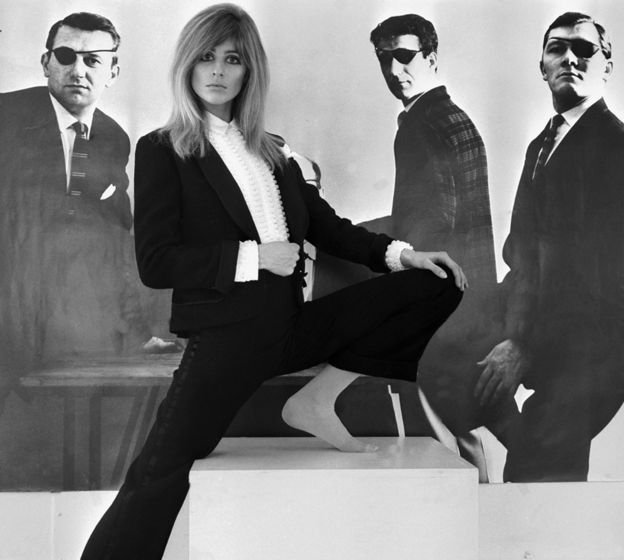 Getty Images
Getty Images
In the aftermath of the fighting, Raymonda was at the battered hospital of the Palestinian city of Nablus, dealing with refugees, the dead and dying, when she heard that the wife of the very man people blamed for the devastation was on her way to visit.
"We were not kind to her," she recalls. "There were the injured people, the corpses, the bodies.
"When they told us it was Ruth Dayan I said 'This is your work, your work!' But she said, 'I am not Dayan.'"
Ruth says simply that her instincts were always humanitarian rather than political. She remembers filling her car with medicines and toys for injured children and then driving it into the Occupied Territories which were under her husband's direct control.
It was an extraordinary moment in a marriage which had never been ordinary.
Ruth continued her visits to Nablus and arranged to see Palestinian women prisoners accused by the Israelis of belonging to a terrorist organisation.
Her husband Moshe was outraged and in the row that followed a critical moment was reached.
Ruth recalls it like this.
"I said, 'Moshe, I want a divorce' and that was after 37 years of being married to him. I do everything on the spur of the moment and I did that too. I said, 'All the time you say that only the way I am working with the Arabs will bring great peace,' and all of a sudden he was cross that I was there. So I did it. I divorced."
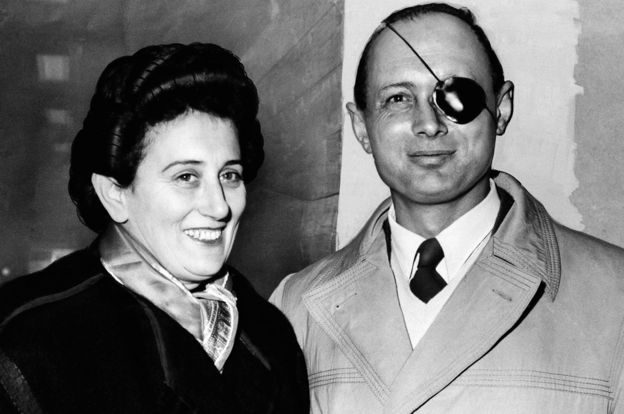 AP
AP
Ruth was as good as her word but the row over her work in Nablus was hardly the first sign of strain in the marriage.
Dayan by that point had a reputation as a serial womaniser and in the book Improbable Friendship there is a poignant anecdote from earlier in the marriage which perhaps hinted at troubles to come.
Ruth was travelling the then newly created country of Israel providing work for women immigrants in a handicraft business that made bags and embroidered clothes.
They were hard times in the Jewish State and she hitchhiked around the country.
One evening her husband's motorcade - he was already a senior military commander - swept past her without stopping as she stood by the roadside, thumb outstretched. It's not clear if he or his men had noticed her but it felt like a bleak portent for the future.
Over time the relationship between Ruth and Raymonda began to develop.
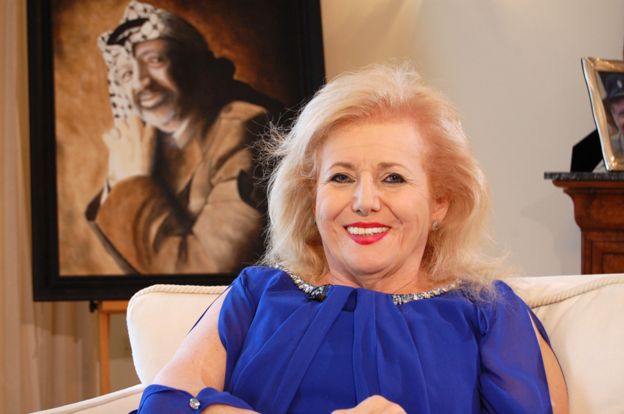
In the early days of the military occupation it was still possible for Israeli peace activists like Ruth to travel into West Bank towns like Nablus to maintain a kind of grassroots dialogue.
It didn't produce peace in the end but those who took part remember it as a noble venture.
"My house was a salon for all these people meeting together to discuss," says Raymonda. "Outside, nobody would understand what was going on on the inside. I had to ask the Mayor to come and the personalities of the town to come and meet with these Israelis and important foreign figures to talk about the future - can you imagine this in 1967?"
The friendship endured in increasingly improbable circumstances.
There was the grim drumbeat of history to emphasise the difficulty of it all - the war of 1973, the Israeli invasion of Lebanon in 1982 and the start of the first intifada, or Palestinian uprising in 1987.
And there was the manner in which their lives, on the surface at least, diverged.
Raymonda became a kind of unofficial spokesperson for the West Bank, a familiar figure in international news broadcasts. There was house arrest and imprisonment by the Israelis suspicious of her contacts with the PLO and threats from extremists on her own side, suspicious of her contacts with Israelis.
Ruth's humanitarian impulses took her further afield. A lifetime of humanitarian work saw her travel everywhere from Congo to Vietnam and brought meetings with everyone from Elizabeth Taylor to Albert Schweitzer.
But always there was contact even if in times of tension it didn't take much to turn the warmth of friendship into the heat of argument.
And the story of their relationship eventually took an even more implausible turn.
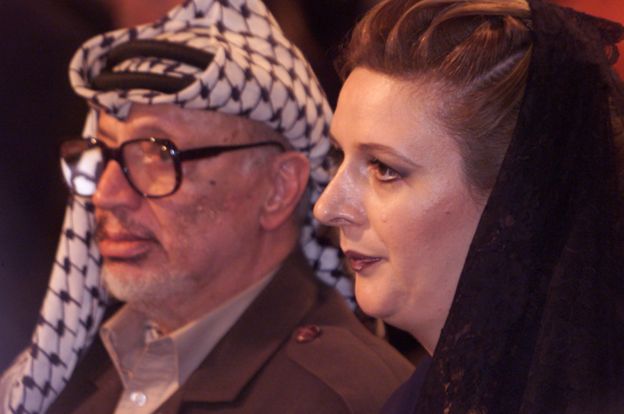 Getty Images
Getty Images
In 1990 Raymonda's daughter Suha married the PLO leader Yasser Arafat - a hero to his own people who revered him as a kind of living embodiment of the Palestinian struggle and Israel's public enemy number one.
The two women now sat in the centre of an extraordinary network of relationships.
Ruth was the divorced wife of Israel's most celebrated warrior. But in addition to that her younger sister Reumah was married to Ezer Weizman - a former fighter pilot who also rose to become a senior military commander and who ended up as Israel's seventh president.
Anyone who was anyone in Israeli public life was in Ruth's contacts book.
Now Raymonda had privileged access to the PLO high command and a personal connection to the man Israel regarded as its most dangerous and determined enemy.
For a time it seemed that extraordinary coincidence might create some sort of back-channel of communication but in the end it came to nothing.
Messages were passed and some meetings were arranged but the crushing weight of the surrounding circumstances was simply too great to allow the fragile network of contacts to make any difference.
 Getty Images
Getty Images
Anyone who knows the Middle East of course would have known that in that strictly political sense this was never going to be a story with a happy ending.
Dayan, Weizman and Arafat are long dead and a lasting agreement seems almost as remote today as it did on the day when Israel's tanks rumbled into Nablus back in 1967.
And yet the relationship between Ruth and Raymonda endures - when we met in Malta, where they had arranged to see each other, they held hands as they sat together on a sofa.
Ruth was full of praise for Raymonda's beauty while Raymonda compared Mrs Dayan to Mother Teresa. They talked over each other and bickered gently in the way that only people who've known each other for a very long time can do.
But for all the gentle warmth they look back on the past with sadness.
I brought footage from the BBC archives to show Raymonda - news reports from the late 1970s in which she appeared as a voice of the Palestinians of the West Bank warning that Jewish settlers would have to leave before there could be a chance of peace.
She watched the images of her younger self in thoughtful silence then said: "My God, the answers I'm giving are the same answers now. It hasn't changed."
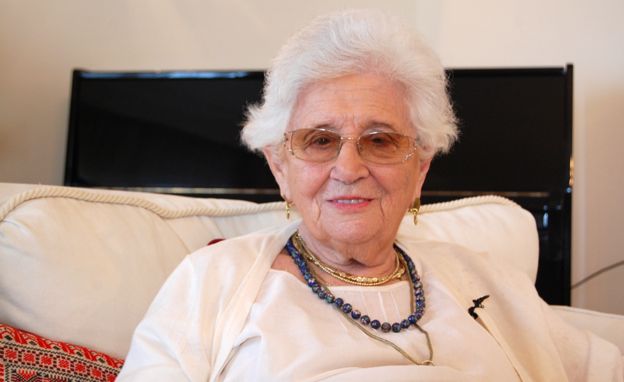
Ruth struck a melancholic note too when I asked her if she was sad that the prospects for real peace between Israel and the Palestinians seem worse now than they've seemed in the past.
"It's sad that I feel I can't do anything," she told me. "Now, I can only go on with my life 'til I die. I'm 98 and a half now and soon I'll be 100."
But it's not in Ruth's nature to be melancholic for long.
She said her great-grandson who's five had had to use his fingers to calculate her age. "He said, 'Wow, that's crazy. You'll be 102 by the time of the next World Cup. So now I have to live to 102!"
The paths that brought these two remarkable women together could hardly have been more different.
Ruth was born when the Holy Land was still under Turkish rule, before the end of World War One and gave up a comfortable middle-class life to marry Moshe and live the hard simple life of a farmer. You sense too that that is how she prefers to see him rather than as the warrior that Israel remembers.
Raymonda was born in the early years of World War Two, in the ancient coastal city of Acre when Palestine was still governed by Britain under a League of Nations Mandate. Her affluent Palestinian family lost their home when Israel captured Acre and were never able to return to it. That sense of personal dispossession still rankles as it does for many Palestinians.
And yet those paths did cross in the city of Nablus in 1967 and have remained interconnected ever since.
Perhaps their story never inspired a greater closeness between their two peoples as they once hoped it might.
But it still stands after all these years as a testament to our human capacity to reach out to one another even in the darkest times.
And it shows that friendship which can sometimes seem a fragile flower can still flourish even in the bleak and rocky landscapes of the Holy Land.
Moshe Dayan 1915-1981
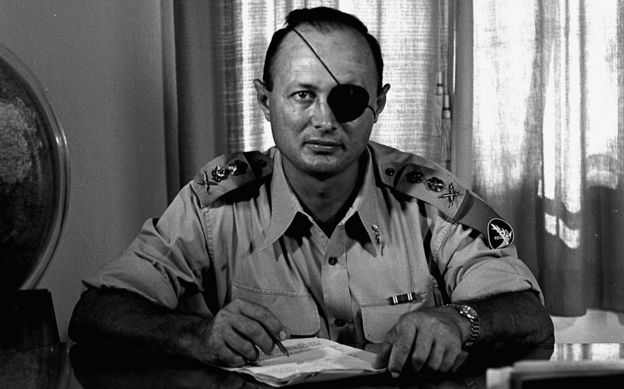 Getty Images
Getty Images- Born in what was then Ottoman Palestine and raised on a co-operative farm, he began his military career in 1937 with British forces fighting Arab militia
- Fought with the Allies against the Vichy French in Syria, where he lost his left eye in action
- Commanded Jerusalem area in Israel's war of independence in 1948, and led 1956 invasion of the Sinai Peninsula as chief-of-staff of Israel's armed forces
- Elected to the Knesset (parliament) in 1959 and appointed minister of defence days before the 1967 Middle East War
- Crossed the political lines to join Menachem Begin's Likud government and was instrumental in reaching the historic Camp David peace accord with Egypt



No comments:
Post a Comment